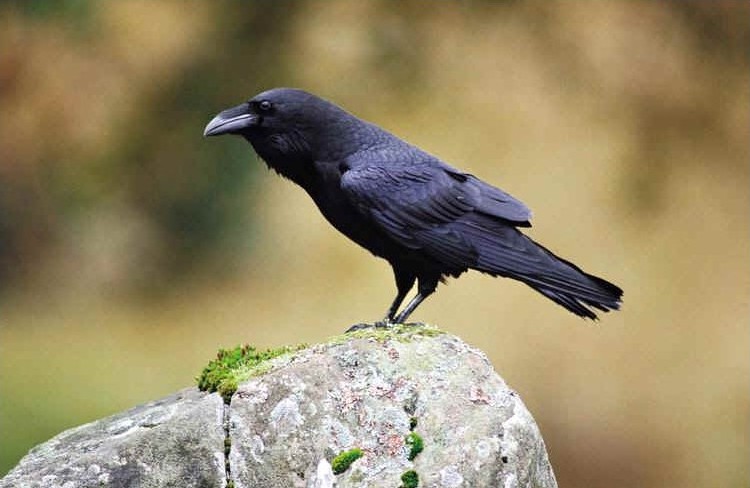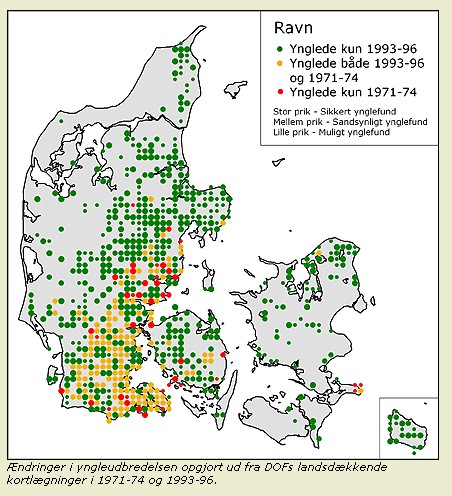RAVEN (Corvus corax)
Description
Raven is our biggest crow bird, the size of a buzzard. It can be mistaken for a carrion crow, but is distinguished by its size, crooked beak and wedge-shaped tail. The voice is a distinctive, deep and far-sounding rårk. The raven has a central role in Norse mythology as Odin's two scouts, Hugin and Munin, always kept him up to date with the latest news. Before the Dannebrog (our flag these days), the Danish flag consisted of The Raven Banner, showing a raven on a solid red background.
Habitat
Raven breeds in most of Europe, apart from parts of western and central Europe. From here propagation stretches eastward through Asia to the Pacific. In Africa, the raven is found only in the northernmost parts. In addition, it is found on Greenland plus large parts of North America. In Denmark, the species is most abundant in southern and eastern Jutland and on Funen, but over the last decades has spread across most of the country.
The raven's choice of breeding place is very versatile. In Denmark, it breeds mostly in old deciduous trees, exceptionally in conifers. The big nest is placed on a v-shaped branch high in the treetops. The raven couple stays together for several years, building additional nests within the territory, and the couple alternates between these from year to year.
Spawning takes place in March-April and it is the female alone that incubates the kids. The old ravens are sedentary birds that remain in the territory year-round while the juveniles occationally are moving around. Ravens stay overnight as other corvids, collectively in selected accommodation spaces.
Feed
Raven is almost omnivorous, but prefers animal food. It feeds primarily on carrion, sick or debilitated animals and birds, their eggs and chicks. Also takes waste from manure heaps, and many invertebrates. Plant food is consumed to a less extent. Raven mainly feeds in open countryside.
Population development
Until middle of the 1800s the raven spawned widely across the country. Then followed a sharp decline due to persecution in the form of shooting and poisoning. In 1950, rural population were reduced to just 16 couples, exclusively in South Jutland and Funen. Since then, the species has been in excellent progress. In 1970, rural population had increased to 120-130 pairs, in the late 1980s it was estimated 200-250 pairs, and in 2000 is estimated 500-700 pairs.
Changes in breeding distribution,
determined through studies 1971-74 and 1993-96.
GREEN DOT: breeding 1993-96 only
YELLOW DOT: breeding 1971-74 AND 1993-96
RED DOT: breeding 1971-74
Big dot: safe breeding finding
Medium dot: probable breeding finding
Little dot: possible breeding finding
Facts
Length: 64 cm.
Weigt: 800-1.500 grams
Litter size: 4-6 eggs
Number of litters: 1
Incubation period: 21 days
UNGETID???: 35-40 days
Breeding stock
Breeding pairs: 500-700
Status (1990-2000): Progress
Change: 10-20%
Conservation ratio
Redlist: -
Yellowlist: -
Birdlife SPEC: -
Birds Directive: -
Hunting season: Protected
ref.: http://www.dofbasen.dk/ART/art.php
=============================================
Danish photographer Carsten Siems has photographed young raven at Runde (Norway):
I started to photograph the bird from a distance, and then approaching slowly. It was brushing up its feathers and prattling. Finally I was only about six or seven meters (20 feet) away from it, and I stood there for long time. A fine experience. The photograph originates from the southernmost bird hill (mountain) just south of Ålesund.Ravens at nest, 1

